MARCH 2020 ENEWS
Dear friends of Fort Ross and Salt Point,
It’s clearly not business as usual at Fort Ross and elsewhere around the globe. Crises like this remind us all how interconnected we are, and we now need to pull together to limit the spread of COVID-19. To ensure we do not put our staff, our visitors, and our local community at risk, please note the following changes in operations. We will re-evaluate the situation in several weeks but it’s possible these closures will continue until the end of April and possibly longer.
- The park grounds are open from sunrise to sunset -- fresh air and wide open spaces are just what the doctor ordered.
- The Fort Ross Bookshop and museum is closed until April 10th.
- The Salt Point Visitor Center, normally open on Saturdays, will remain closed.
- Group tours and events are canceled through April.
- Overnight school groups scheduled to come in the next six weeks are being rescheduled or cancelled.
- Thursday, March 19th Viola Adunca training is postponed.
- The April 4th, First Saturdays Call House Museum, Windmill Demonstration, and Talk & Tea will not take place.
- Our April 25th Fort Ross Conservancy Members’ Meeting will be rescheduled to June 20th, 2020.
- Our April 25th Earth Day and Spring Celebration are canceled - but we hope to reschedule the invasive species service project for some time this summer.
Over these coming weeks I hope you make every effort to spend time outdoors. A hike along any of the Salt Point trails or a bluff walk at Fort Ross will surely calm the spirit and provide strength for what lies ahead. Or closer to home, find a quiet footpath or spacious park bench and take in the fresh air.
This month’s newsletter has some interesting, diverting stories to momentarily take you away from the headlines: Fort Ross State Historic Park just got a little bigger, the golden poppies are blooming brightly, and there’s some movement on how best to protect our undersea gardens, the kelp forests. For future updates, and to enjoy a gorgeous slide show of Fort Ross and Salt Point beauty shots, visit www.fortross.org.
Wishing you excellent health, a well stocked pantry, and a robust internet connection,
-Sarah
Bufano Peace Statue: 50 Years of Modernist Art on the Sonoma Coast
Story from: William Maslach, Sonoma-Mendocino Coast District
Have you ever visited a California state park that can hold no more than a couple dozen people? The Bufano Peace Statue (Unit #212) was such a place. Even Huell Howser put it on his bucket list.
If you haven’t been there, sadly it’s too late to say you visited the second-smallest state park in California. In 1994, this 0.26-acre rocky knoll at the edge of the Pacific Ocean was incorporated into Fort Ross State Historic Park, albeit a geographically disjunct parcel. It’s one of those parks on the “Units and Properties That Have Changed Their Identities” list in the State Parks “Planning Milestones” publication.
The artist of the statue, Beniamino “Benny” Bufano, was an Italian American sculptor known for impressively large monuments styled with themes of peace. His work in the 20th century is generally classified as modernism—think Picasso, Frank Lloyd Wright and especially post-World War I art. In 1970 he completed the 93-foot, 20-ton obelisk of concrete, redwood, tile and, apparently, lead. The artwork was located on property owned by the Timber Cove Resort and later gifted to State Parks. Coincidental or intentional, the towering missile-shaped monument to peace built during the height of the Cold War sits across the bay from the former Russian outpost of Fort Ross.
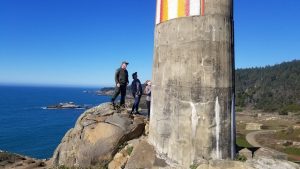
The obelisk is adorned with beautiful mosaics of half-inch ceramic tiles and topped with a sculpture of an open hand, which is also covered with colorful tiles. But the ocean wind and saltwater spray have taken their toll on the 50-year-old monument. Design Manager Jennifer Cabrera and Senior State Archaeologist Dionne Gruver, both from the Northern Service Center, met Sonoma-Mendocino Coast District Superintendent Terry Bertels on-site to gather some of the fallen tiles and discuss opportunities for contracting a conservator to assess, and possibly restore, Benny Bufano’s last and largest sculpture.
If you don’t have thousands of dollars for a small Bufano bronze sculpture, you can check out the Peace Statue on the northern Sonoma Coast. It’s next to Timber Cove Resort, where you can order your favorite drink and complete your art tour with a dose of mid-century modern architecture and furnishings—as well as more art by Bufano.
California’s Living Gold: The California Poppy
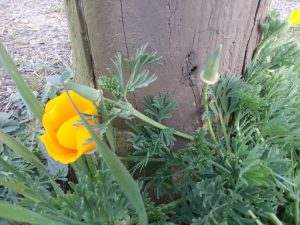
For anyone who has taken a drive along California’s Pacific Coast Highway recently, you will have likely noticed our state flower brightening up roadsides with its radiant color. One look at a California poppy and it’s easy to understand why people thought this flower would be a perfect symbol of California’s nickname, the Golden State. In fact, other common names for the California poppy include: golden poppy, flame flower and copa de oro--which translates from spanish to cup of gold. This brilliant orange and yellow wildflower is the complete package. It’s not only beautiful but it has important traditional and medicinal uses, and plays a continuing key role in the health of our environment. It is truly California gold.
California poppies have long captured the attention of visitors from afar. Early Spanish settlers nicknamed the California coast the “Land of Fire'' when they saw these bright flowers glowing in great numbers. It is said that they could guide their ships at night by the poppies’ fiery light. The California poppy’s scientific name traces back to 1816 when the Russian ship Rurik voyaged to California as part of a scientific expedition around the world. Among the ship’s passengers were French-born explorer and naturalist Adelbert von Chamisso and German naturalist and physician Johann Friedrich Eschscholtz. Chamisso collected the California poppy and named it Eschscholzia californica, in honor of his friend and shipmate. The type specimen for the California Poppy is currently held at the Herbarium in St. Petersburg, Russia.
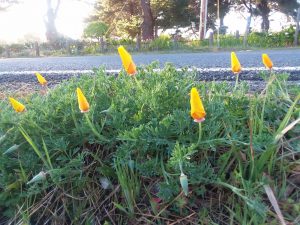
The cultural significance of California poppies is widespread among native peoples from California and beyond. This gentle wildflower was well known long before the arrival of European explorers and settlers. Poppy plants were prepared into nutritious foods and the mildly sweet flowers made for a pleasant chewing gum or candy. The colorful pollen was applied as eye shadow and used as body paint on special occasions. Poppies were used to alleviate toothaches and heal the navels of newborn babies. The Ohlone used a decoction prepared from the flowers to rid the scalp of lice. Mashed poppy seed pods were made into medicine to help Pomo mothers stop nursing. Medicinal properties of the poppy made it especially useful as a gentle sedative and sleep aid. Poppy plants were placed under children’s beds when they were restless and needed help falling to sleep. It’s even been said that poppies were used to stupefy companions when gambling--try this at your own risk!
Because of its continued usefulness as a sleep aid, anxiety soother, and pain reliever, you can find many medicinal products containing the California poppy today. Not to be confused with its infamous cousin the opium poppy, the California poppy is gentle enough to be used in remedies for children suffering from conditions involving pain, headache, and irritability.
California poppies seem well tuned to the rhythms of the sun. During the day the flowers radiate and glow, reflecting the sun’s brightness and warmth. When the sun sets the flowers close up as if they are going into a restful sleep for the night. This plant behavior, known as nyctinasty, could be why people first thought to try using poppies as a sleep medicine. We all know life can throw any number of potential stressors our way. Isn’t it amazing that this flower has shone so brightly, letting us know it’s here and can provide a natural means of support?
It’s not only people that have found a friend in this flower. Poppies depend on pollinators in order to reproduce and so provide pollen to a variety of bees, bugs, and beetles. Important evidence also suggests that up to five species of specialist butterflies rely upon this flower’s pollen. Poppies are also a good food source for small herbivores such as rabbits. And because the poppies have a very long blooming season (beginning as early as February and lasting as late as November) they provide an important food source for much of the year. The poppies’ usefulness doesn’t stop there; their roots stabilize soil and help with erosion control. When you see poppies growing along the highway, it's nice to remember they’re not only providing beauty but helping support the soil from being swept away by wind and rainfall.
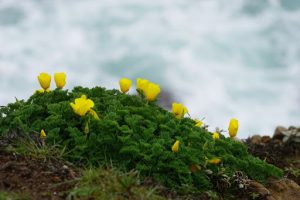
This is a great time to take in the beauty of California’s gold at your favorite state parks. At Fort Ross and Salt Point you can walk along the bluffs and enjoy the lovely two-toned coastal poppy variety which is predominantly bright yellow with orange in its center. There are also many other living treasures to behold here: the bright green footprints of spring, the rich purples of the native Douglas iris and viola adunca, the cheerful white flowers of coastal strawberries not quite ready to fruit. We hope you never need an excuse to take in the relaxing and healing power of California's gold, but if you do, consider marking your calendar on April 6th--California Poppy Day! With all that the native poppy has to offer is it any wonder that Californians now have a holiday to honor the past, present and future contributions of this special wildflower?If you’d like to learn more about the California poppy, or any other number of related topics, we have a wonderful selection of books at our bookshop and library, both located at Fort Ross State Historic Park. If you prefer information at your fingertips, here are some interesting online resources for you to enjoy:
- California Department of Fish & Wildlife: California Poppy
- California Native Plant Society: California poppy
- Flower Essence Society: California Poppy
- Live Science: Why flowers close at night
- National Park Service: Adelbert Von Chamisso
- National Park Service: California Poppy
- USDA Natural Resources Conservation Service: California Poppy
--Charon Vilnai, Programs Instructor, Sea Lion Survey Project Lead, and Call House Museum Lead
The Kelp Gets Help!
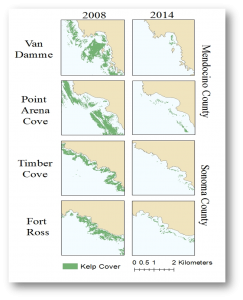
Each month, the Fort Ross Conservancy (FRC) team works to bring our readers interesting and relevant enews articles. We cover a variety of topics including California history, Fort Ross/Russian era history, Ranch era history, as well as stories from or about the Kashia Pomo and Alaska Natives whose stories are inextricably tied to these lands. FRC staff is also made up of passionate California naturalists, who take great joy in writing about a wide and varied selection of natural history topics. One such topic that has been of particular interest to me is the recent Bull Kelp loss on the Sonoma and Mendocino counties.
Kelp forests are also an essential coastal habitat, providing food and shelter for thousands of marine species. The California Department of Fish and Wildlife reports that since 2014, more than 90% of bull kelp canopy in the Sonoma-Mendocino county region was lost due to a “perfect storm of ecological impacts,” including increased ocean temperatures, harmful algal blooms, and booming populations of kelp predators like purple urchins. While many factors played a role in the current imbalance within the intertidal zone and some of them have evened out a bit, the loss of the kelp along our coast is getting worse.
This article will give some background information on how the Bull kelp have become imperiled and also announce some exciting news about the ongoing efforts to restore balance to our coastal habitat.
As illustrated in the previous enews article, Searching for Balance in an Underwater World Gone Upside Down, this loss is unprecedented and has incredibly far-reaching repercussions for not only the marine environment where Bull kelp is found, but even for us land dwellers. With any crisis, it’s important to understand the “so what” of it, so that we may gain clarity on the issue, develop empathy for what’s at stake, and care enough to make a difference. So how does this loss of Bull Kelp affect us? To start, the amount of carbon sequestered by kelp forests is 20 times greater per acre than the amount of carbon sequestered by other terrestrial forests. With atmospheric carbon dioxide higher now (407ppm) than even at its previous historic high point of 300 ppm about 3 million years ago, plants sequestering carbon has the greatest single impact on limiting fossil-fuel-driven climate change.
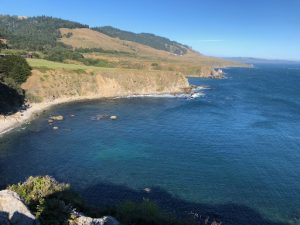
For many years, continuously warmer waters allowed a densovirus, now known as the sea star wasting disease to decimate the subtidal and intertidal sea star species. The Sunflower Star (Pycnopodia helianthoides) and the Ochre Sea Star (Pisaster ochraceus), had been keeping the population of the Purple Sea Urchin (Strongylocentrotus purpuratus) in balance. With no remaining predators (other than humans), the massive urchin population transformed the sea floor into what are called urchin barrens. These fields of urchins have consumed all of the Bull kelp. Bull kelp is a species of annual seaweed that, at times in Spring, grows up to ten inches a day. Its canopy is focused at the ocean's surface, as each stipe (stalk) ends in a gas filled bulb. Each bulb has many leaflike blades, sometimes over three meters long. It provides a sanctuary and food source for a wide diversity of mammals, fish, and invertebrates.
Due to the urchin's voracious appetite, Red abalone (Haliotis rufescens) lost their primary food source, the Bull kelp. Searching for a new food supply, they travel higher in the intertidal zone, however, they are not able to find enough food to remain strong and healthy and, as a result, are dying en masse.
Today, our waters continue to stay far warmer than in previous years, leaving room for continued changes to the environment and the wasting disease and urchin populations to thrive. These are all very clear signs of our rapidly changing climate. When one looks out over the coves at Fort Ross or Salt Point on a summer day, there may be five to ten solitary kelp stipes, a stark contrast to only a few years ago when entire coves were filled with undulating carpets of olive-green seaweed.
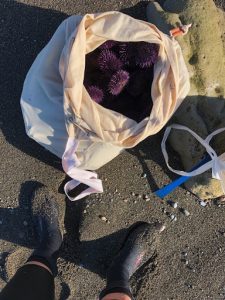
Initially, it was local residents, divers, fishermen, scientists, and naturalists who brought awareness of this issue to the greater public. Since then, multiple agencies, organizations, and many caring individuals have been working tirelessly to determine the causes, research possible solutions, and implement them before it’s too late.
On June 4, 2019, The Greater Farallones Association released a comprehensive Sonoma-Mendocino Bull Kelp Recovery Plan. The Plan, created by The Greater Farallones National Marine Sanctuary, the California Department of Fish and Wildlife (CDFW), and The Greater Farallones Association, aims to “restore kelp populations through multi-phase, science-based research and restoration projects.”
Still, it has been an uphill battle for many reasons, but in the last six weeks, there have been two excellent developments!
On January 30, 2020, the California Department of Fish and Wildlife published a statement lifting the already much- expanded daily bag limit of purple sea urchin (PSU) in certain areas of Mendocino county. This will allow for underwater culling, meaning divers can now smash the urchin in place instead of removing them. Originally, CDFW scientists worried that underwater culling might trigger spawning events, which would simply exacerbate the issue. What’s been discovered recently is that the PSU are now starving themselves to the point that they are too malnourished to broadcast spawn, thus making underwater culling a viable method of population control. Before this new rule, the incredibly labor intensive chore of removing mass PSU, meant it did not happen frequently enough or cover enough ground.
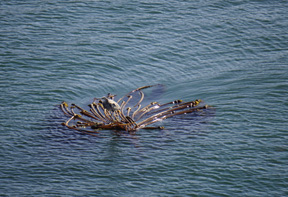
Recreational divers engaging in the manual removal and/destruction of the bulk of PSU populations is an important step in maintaining the remaining stands of bull kelp. The CDFW report states:
The environmental conditions in northern California have continued to deteriorate. By 2019, divers from the California Department of Fish and Wildlife observed very few remaining patches of bull kelp in northern California as well as a sustained decline in species diversity that would otherwise inhabit a healthy bull kelp ecosystem; this condition has been corroborated by local divers and research entities such as Reef Check California. The remaining stands of kelp tend to occupy the top of isolated, frequently disturbed boulders and rock formations that are more difficult for PSU to reach. However, Department staff is extremely concerned that the expanding PSU population may soon reach the remaining stands. As annual plants, bull kelp require a large standing spore stock to persist successfully. Preserving the remaining stands is critically important in the effort to rebuild this biogenic habitat upon which a myriad of native species including red abalone rely...One of the primary tools is creating a network of kelp spore “refuges” in localized areas throughout the north coast by locally controlling PSU presence...A reduction in PSU populations, even in just one selected location to prevent loss of the remaining bull kelp spore refuges, is critical to the restoration and recovery of the ecosystem, including red urchin and red abalone populations.
The second positive development occurred on February 26, 2020, when Reef Check was awarded a $500,000 grant from the California Ocean Protection Council (OPC) to begin these kelp forest restoration efforts in Mendocino County. Together, with commercial fishermen and recreational divers, Reef Check aims to remove urchins from the targeted locations with the goal of providing opportunities for kelp forest to regrow where they once were abundant.
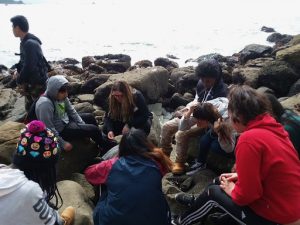
So, how can we as individuals help the kelp? The organization California Reef Check offers opportunities for divers to get involved in the kelp forest monitoring program. The Greater Farallones and NOAA’s Beach Watch Program offers extensive trainings for those interested in becoming a monthly beach surveyor. Beach Watch participants monitor live and dead seabirds and marine mammals on a specific stretch of beach to provide a baseline dataset, as well as report the presence of oil pollution, human impacts, and marine mammal strandings. All of this data adds to our knowledge as we continue to see the potential effects of climate change.
FRC continues to inform school-aged children and visitors through its programming, enews articles, social media posts and visitor interactions. Through FRC’s Marine Ecology Program MEP, FRC plays an important role in educating and inspiring the next generation of ocean stewards. Working together, individuals and these organizations can make a difference.
--Song Hunter, Director of Programs
At the Dock: Viruses & Vaccines at Metini-Fort Ross
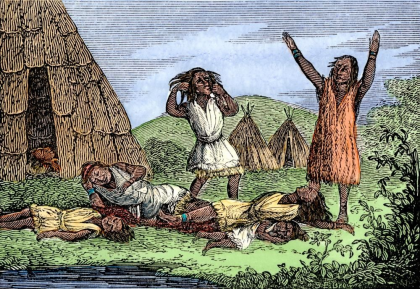
Several hundred years ago, European diseases were reducing the indigenous population of the Americas by up to 90%. Experiencing and responding to infectious diseases was very different then, but even as early as the Fort Ross era vaccinations were used. In fact, the first vaccinations used in California were brought to Monterey by a Russian American Company ship and surgeon. We’ve collected a brief timeline of virus and vaccine-related events and several first-person testimonials of how these events affected the people of Metini-Fort Ross.
Timeline
- 1768 - First inoculation in Russia given to Catherine The Great.
- 1763 - Smallpox infested blankets first used as a weapon of war by the British against Native Americans besieging Fort Pitt.
- 1798 - Smallpox vaccination procedure first published by Englishman Edward Jenner.
- 1800 - First smallpox vaccine in the United States, in Boston.
- 1805-6 - Smallpox vaccinations first brought into New Mexico and Texas from Mexico
- 1821 - The first vaccination in California history was given to 54 people in Monterey by the surgeon on the Russian American Company vessel Kutuzov, arriving from Callao, Peru. The vaccine arrived in 1806 with the Spanish Philanthropic Expedition of the Vaccine.
- 1828 - Measles outbreak in Alta California.
- 1833 - Malaria outbreak at Settlement Ross.
- 1833- The Hudson Bay Company was kept at some distance from Fort Ross as they passed by, due to concerns of infection.
- 1837-8 - Deadly epidemic of smallpox came to Settlement Ross via New Archangel, killing thousands of Native Californians and affecting people as far away as Mt. Shasta.
Glimpses into the past
“In (April) 1833, the John Work party of the Hudson’s Bay Co., 163 people and 400 horses and mules, came towards Fort Ross, heading north, looking for beaver. Commandant Kostromitinoff would not allow them to stay at the Fort for fear of malaria, so they went on up the coast another five miles to camp…”
- The Old Salt Point Township, Volume 1, Lynn Hay Rudy
“...Disease, too, took a toll of farm hands. Measles took the lives of twenty-nine Creoles and Aleuts at Ross within three weeks in April of 1828. Five years later an unknown springtime infection incapacitated nearly everybody at the fort and killed many Indians. And the counter did not escape the smallpox epidemic of 1835–8 on the Northwest Coast. In 1838 ‘many’ of the Indians working at Ross contracted the disease; mortality was ‘not great’, supposedly because of the fine weather. Vaccine – ‘as much as could be spared’ – had arrived from New Archangel in the fall of 1836 on the brig Baykal, and more had been received at the end of 1837, whereupon 280 locals (139 Indians, 83 Creoles, 56 Aleuts, and 2 Californios) were vaccinated (two of whom died).”
- Russian California, 1806-1860, James Gibson & Alexei Istomin
“...From New Archangel (Sitka) the disease was probably taken to Ross by seamen. In late 1837 General Vallejo sent a detachment under Ignacio Miramontes, a cavalry corporal, to Ross to buy some goods (including cloth and leather) for his soldiers. His men ‘returned to Sonoma infected with smallpox that propagated itself here with such virulence that it almost exterminated everyone’ as far as Mount Shasta, costing altogether the lives of 100,000 non-mission Indians, 3,000 mission Indians and mestizos, and 200 whites. Its mortality at Ross was lower than elsewhere in California, especially the northern half, where as many as three-fifths of the natives may have perished. Pursuing a policy of vaccination of the entire population of the colony, especially the Indians (who constituted 139 of the 280 vaccinees), the counter’s management minimized the number of victims among the colony’s residents and mitigated the consequences of the epidemic for those Indians who were driven seasonally to Ross. Of the 280 vaccinees, two died (including one Indian woman). During the epidemic Ross Counter, as Governor Kupreyanov reported, rendered ‘all possible assistance to not only our own people but also the Indians’. But the spread of the disease to the interior in 1838 continued to ravage the ‘savages’. At Ross Kupreyanov ‘noticed that most of the Indians bore the marks [scars] of smallpox, and many of those working on the ploughland were stricken with it, but the mortality was not high’. He recommended that the counter continue to vaccinate the Indians whenever possible…”
- Russian California, 1806-1860, James Gibson & Alexei Istomin
--Hank Birnbaum, FRC Bilingual Guide, Educator & Historical Specialist
State Parks Campground Host Opportunity for Salt Point State Park
Salt Point State Park • Woodside campground is located about 1 hour north of Bodega Bay and offers up to 78 campsites.
The camp host will provide information to visiting public, report medical emergencies, and other park related problems to the staff, and supplement the maintenance staff by performing minor housekeeping in the campground rest rooms. The camp host must be willing to work with people and possess good communication skills as well as possess the ability to collect fees for firewood, make change, and perform simple accounting procedures. The camp host reports to the Russian River Sector ranger staff. The camp host must be willing to work weekends and holidays. The schedule for this position is 4 days on and 3 days off with one weekend day off. Applicants must be willing to commit to at least a 3 month commitment. State Park staff will train new hosts with their volunteer campground responsibilities,
More information at: https://www.parks.ca.gov/?page_id=911. For any questions regarding this position, please email Ranger Trevor Nealy at trevor.nealy@parks.ca.gov or call at (707)875-3483.
FRC Members' Meeting
Fort Ross Conservancy Annual Members' Meeting has been moved to June 20th, 2020. Please RSVP to Sarjan Holt at sarjanh@fortross.org.